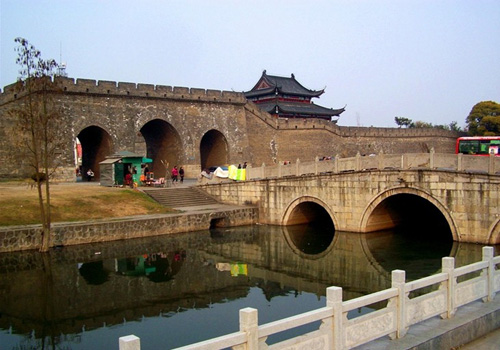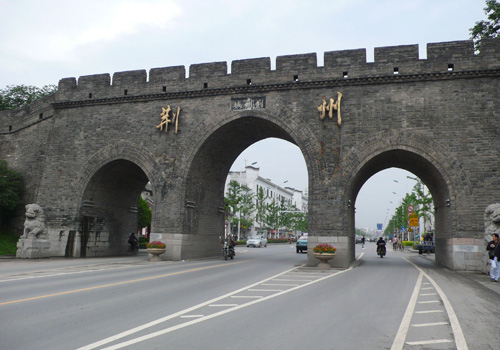Jingzhou Ancient City Wall
Jingzhou Ancient City Wall
Called Jiangling City in ancient times, Jingzhou City in central China’s Hubei Province was the capital of Chu in the Eastern Zhou Dynasty (770BC–221BC) in Chinese history. Jingzhou Ancient City Wall, one of the best preserved ones in China, is just located in Jingzhou District of this city with long history. In fact, the whole ancient city wall is composed of three parts, namely the outermost water city wall, the in-between brick city wall and the innermost earth city wall. The extant brick city wall has a circumference of around 11 kilometers and a height of 9 meters. With most of which reconstructed during Ming Dynasty (1368AD–1644AD) and Qing Dynasty (1644AD–1911AD), the ancient city wall was listed as a national key cultural relic protection unit by Chinese government in 1996.

According to some record, the construction of Jingzhou Ancient City Wall can be dated back to the Western Zhou Dynasty (1046BC–771BC), though it has not been testified, an archaeological discovery in 1998 indicated that the brick ancient city wall had initially been built at least in The Five Dynasties (907AD–960AD), which is about 400 years earlier than Ming Dynasty, the time once widely acknowledged that the brick part of Jingzhou Ancient City Wall was started to be built. The archaeological discovery also implied that the history of earth city wall is much earlier than the brick part. The extant brick city wall built during Ming and Qing dynasties is complete and solid, and the wall is constructed of special black bricks with lime and glutinous rice paste. Each black brick has an approximate weight of 4kg, some of which were even fired with letters.

After two major repairs in 1789 and 1792, Jingzhou Ancient City Wall preserved six main city gates, which were named according to local geography, history and customs. The gates in the east, south, west, north, northeast and southeast were respectively called Yinbin Gate, Nanji Gate, Anlan Gate, Gongji Gate, Yuan’an Gate and Gong’an Gate (Water Gate), forming the main scenery of the ancient city wall.
Yinbin Gate was for welcoming representatives from imperial court and other visitors, thus the gate tower is grand and the enclosure for defense outside the city gate is the largest.
Facing a river in the south, Nanji Gate was a comparatively busy one among the six ancient city gates. Emperors and noblemen, merchants and common people in ancient times came and went through this gate. On left and right sides of the enclosure for defense outside the city gate are two side gates to attack enemies who intended to enter the city.
Ever named Longshan Gate in Ming Dynasty, Anlan Gate had been subjected to floods due to its low-lying terrain. The city gate was once broken down in a flood happened in 1788. After elevating the foundation and reconstructing the gate, it was renamed Anlan (literally means controlling billows) with the wish of preventing floods.
Located in the north, Gongji Gate was the main one leading to Central Plain (or Zhongyuan, comprising the middle and lower reaches of the Yellow River which formed the cradle of Chinese civilization) in ancient times. People to seek official positions via imperial examinations or to take up official posts in Central Plain usually passed through Gongji Gate to the north. The family members or friends would break off twigs from willow trees and send them to express their feeling of sadness at these partings. Consequently the city gate was called Willow Gate as well.
The gate in the southeast was named Gong’an Gate for it faces Gong’an County in Jingzhou City. It is also called Water Gate since only waterway is available to the gate. Liu Bei (161AD-223AD; who founded the state of Shu in the Three Kingdoms Period in Chinese history) escorted his bride Miss Sun to their wedding here.
New gates have been opened after reform and opening-up in China in order to release the transportation pressure of the ancient city gates, while nowadays Jingzhou Ancient City Wall is not the military defense facility but the cultural relic, telling people the long history it has experienced.




